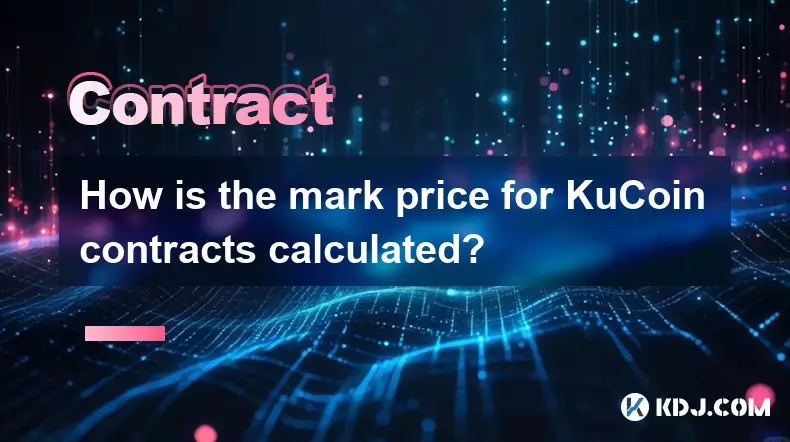-
 bitcoin
bitcoin $122090.672462 USD
1.59% -
 ethereum
ethereum $4493.758974 USD
0.56% -
 xrp
xrp $3.033145 USD
0.65% -
 tether
tether $1.000629 USD
0.00% -
 bnb
bnb $1169.854250 USD
7.07% -
 solana
solana $230.954786 USD
-0.19% -
 usd-coin
usd-coin $0.999785 USD
0.00% -
 dogecoin
dogecoin $0.256108 USD
-1.12% -
 tron
tron $0.342333 USD
-0.12% -
 cardano
cardano $0.859632 USD
-0.10% -
 hyperliquid
hyperliquid $48.932146 USD
-2.25% -
 chainlink
chainlink $22.345466 USD
-1.29% -
 ethena-usde
ethena-usde $1.000217 USD
-0.03% -
 avalanche
avalanche $31.203456 USD
1.93% -
 sui
sui $3.579145 USD
1.05%
How is the mark price for KuCoin contracts calculated?
KuCoin's mark price uses a multi-source index, TWAP smoothing, and funding rates to ensure fair valuation and prevent manipulation in futures trading.
Sep 19, 2025 at 06:01 pm

Understanding the Mark Price Mechanism on KuCoin Futures
1. The mark price on KuCoin futures contracts is primarily designed to reflect the fair value of a cryptocurrency derivative and prevent unnecessary liquidations due to market manipulation or extreme volatility. It is not based solely on the last traded price of the contract but instead uses a composite calculation involving multiple data sources.
2. One key component in the calculation is the spot price index, which aggregates the average trading price of the underlying asset across major spot exchanges. KuCoin selects reputable exchanges with high liquidity and trading volume, such as Binance, Coinbase, and Kraken, to compute a weighted average. This ensures that the index remains resistant to outliers or flash crashes on any single platform.
3. To further stabilize the mark price, KuCoin implements a time-weighted average price (TWAP) over a specific period for the index. This smoothing technique reduces the impact of short-term spikes or dips, offering a more accurate representation of the asset’s true market value at any given moment.
4. For perpetual contracts, funding rate mechanisms are integrated into the mark price logic. When the contract price significantly deviates from the spot index, funding payments are exchanged between long and short positions. This economic incentive encourages traders to bring the market price back in line with the mark price, reinforcing price convergence.
5. The final mark price also incorporates an anchor mechanism in certain conditions. If the difference between the index price and the market price exceeds a predefined threshold, an adjustment factor may be applied. This helps maintain order during periods of low liquidity or abrupt macroeconomic events affecting crypto markets.
Data Sources and Index Aggregation
1. KuCoin pulls real-time spot prices from a curated list of top-tier exchanges. These exchanges must meet strict criteria regarding uptime, trade volume, and resistance to spoofing or wash trading.
2. Each exchange's contribution to the index is weighted according to its 24-hour trading volume for the specific asset. Higher-volume platforms have greater influence on the final index value, enhancing reliability.
3. Outliers are filtered using statistical methods such as median selection or trimming extremes before averaging. This prevents distorted inputs from skewing the overall index.
4. The aggregated index is updated every few seconds, ensuring the mark price remains responsive while avoiding excessive noise.
5. Transparency is maintained through public documentation detailing which exchanges are included and how weights are recalculated periodically based on shifting market dynamics.
Role of Funding Rates in Price Alignment
1. Perpetual contracts on KuCoin do not have an expiration date, so funding rates are essential for aligning the contract price with the mark price. These periodic payments occur every eight hours.
2. When the contract trades above the mark price, funding rates turn positive, meaning long position holders pay shorts. This incentivizes selling pressure, pushing the price down toward equilibrium.
3. Conversely, when the contract trades below the mark price, funding rates become negative, and short position holders pay longs. This encourages buying activity, lifting the price back up.
4. The magnitude of the funding rate depends on the deviation between the market price and the mark price, as well as prevailing interest levels in the market.
5. This continuous feedback loop ensures that speculative imbalances are corrected without relying solely on arbitrageurs or external market forces.
Frequently Asked Questions
What happens if one of the index exchanges goes offline?KuCoin has failover protocols in place. If a source exchange becomes unavailable, its weight is temporarily redistributed among the remaining active exchanges. The system continues calculating the index using available data, minimizing disruption.
Can traders manipulate the mark price?Direct manipulation is highly improbable due to the multi-source aggregation model. An attacker would need to simultaneously distort prices across several major exchanges, which is economically unfeasible given their depth and regulatory oversight.
Is the mark price visible to users on the trading interface?Yes, the mark price is displayed prominently on the futures trading page, typically near the current market price. Users can monitor it in real time to assess their risk exposure and potential liquidation levels.
Disclaimer:info@kdj.com
The information provided is not trading advice. kdj.com does not assume any responsibility for any investments made based on the information provided in this article. Cryptocurrencies are highly volatile and it is highly recommended that you invest with caution after thorough research!
If you believe that the content used on this website infringes your copyright, please contact us immediately (info@kdj.com) and we will delete it promptly.
- BlockDAG, DOGE, HYPE Sponsorship: Crypto Trends Shaping 2025
- 2025-10-01 00:25:13
- Deutsche Börse and Circle: A StableCoin Adoption Powerhouse in Europe
- 2025-10-01 00:25:13
- BlockDAG's Presale Buzz: Is It the Crypto to Watch in October 2025?
- 2025-10-01 00:30:13
- Bitcoin, Crypto, and IQ: When Genius Meets Digital Gold?
- 2025-10-01 00:30:13
- Stablecoins, American Innovation, and Wallet Tokens: The Next Frontier
- 2025-10-01 00:35:12
- NBU, Coins, and Crypto in Ukraine: A New Yorker's Take
- 2025-10-01 00:45:14
Related knowledge

What is the difference between futures and perpetual contracts for Bitcoin?
Oct 02,2025 at 11:54pm
Understanding Bitcoin Futures Contracts1. Bitcoin futures are derivative instruments that allow traders to speculate on the future price of Bitcoin at...

What is the best time to trade PEPE contracts?
Oct 03,2025 at 11:54am
Understanding PEPE Contract Volatility1. PEPE contracts exhibit extreme price fluctuations due to their meme-based nature and low market cap. Trading ...

What are the common mistakes to avoid with Bitcoincoin contracts?
Oct 03,2025 at 08:54am
Emerging Trends in the Cryptocurrency Market1. Decentralized finance (DeFi) platforms continue to expand their influence across the blockchain ecosyst...

What is the maintenance margin for Bitcoin contracts?
Oct 02,2025 at 01:36am
Decentralized Exchanges Gain Momentum in 20241. Decentralized exchanges (DEXs) have seen a significant rise in trading volume, surpassing centralized ...

How to use technical analysis for trading XRP contracts?
Oct 03,2025 at 01:18pm
Understanding Price Patterns in XRP Futures1. Identifying chart patterns such as triangles, head and shoulders, and double tops or bottoms can provide...

What does "longing" PEPE contracts mean?
Oct 03,2025 at 11:54pm
Understanding Decentralized Exchanges in the Crypto Ecosystem1. Decentralized exchanges (DEXs) operate without a central authority, allowing users to ...

What is the difference between futures and perpetual contracts for Bitcoin?
Oct 02,2025 at 11:54pm
Understanding Bitcoin Futures Contracts1. Bitcoin futures are derivative instruments that allow traders to speculate on the future price of Bitcoin at...

What is the best time to trade PEPE contracts?
Oct 03,2025 at 11:54am
Understanding PEPE Contract Volatility1. PEPE contracts exhibit extreme price fluctuations due to their meme-based nature and low market cap. Trading ...

What are the common mistakes to avoid with Bitcoincoin contracts?
Oct 03,2025 at 08:54am
Emerging Trends in the Cryptocurrency Market1. Decentralized finance (DeFi) platforms continue to expand their influence across the blockchain ecosyst...

What is the maintenance margin for Bitcoin contracts?
Oct 02,2025 at 01:36am
Decentralized Exchanges Gain Momentum in 20241. Decentralized exchanges (DEXs) have seen a significant rise in trading volume, surpassing centralized ...

How to use technical analysis for trading XRP contracts?
Oct 03,2025 at 01:18pm
Understanding Price Patterns in XRP Futures1. Identifying chart patterns such as triangles, head and shoulders, and double tops or bottoms can provide...

What does "longing" PEPE contracts mean?
Oct 03,2025 at 11:54pm
Understanding Decentralized Exchanges in the Crypto Ecosystem1. Decentralized exchanges (DEXs) operate without a central authority, allowing users to ...
See all articles










































































